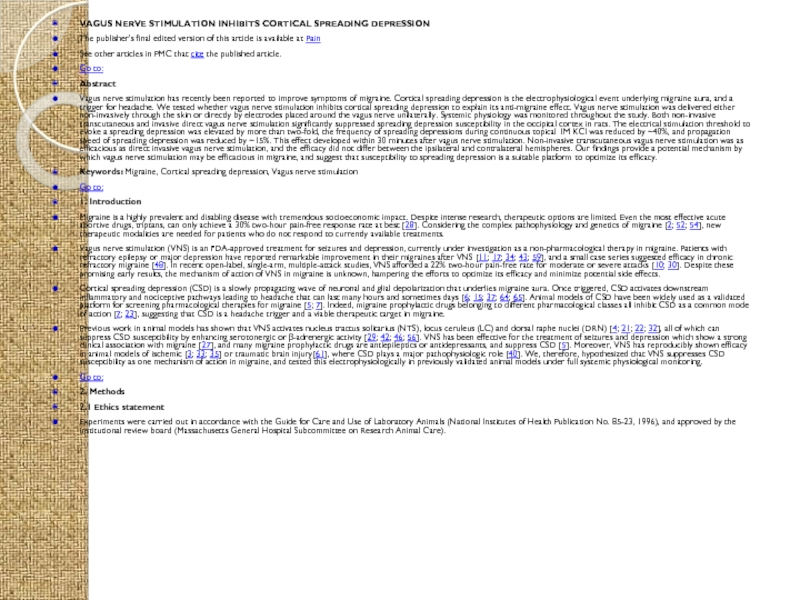Слайд 2Актуальность
Кластерная головная боль (СН) значительное время накладывает здравоохранения и затрагивает приблизительно
1 в 1000 человек во всем мире, с хронической кластерной головной боли (ССН) , содержащей от 10% до 15% случаев. Клинические исследования и основанные на фактических данных рекомендации по профилактике СН ограничены, и некоторые профилактические варианты лечения этого заболевания.
Кластерная головная боль - самый частый вид тригеминальных вегетативных цефалгий, ктоторый характеризуется уникальным видом головной боли в сочетании со столь же уникальными сопровождающими симптомами.
Слайд 11VAGUS NERVE STIMULATION INHIBITS CORTICAL SPREADING DEPRESSION
The publisher's final edited version
of this article is available at Pain
See other articles in PMC that cite the published article.
Go to:
Abstract
Vagus nerve stimulation has recently been reported to improve symptoms of migraine. Cortical spreading depression is the electrophysiological event underlying migraine aura, and a trigger for headache. We tested whether vagus nerve stimulation inhibits cortical spreading depression to explain its anti-migraine effect. Vagus nerve stimulation was delivered either non-invasively through the skin or directly by electrodes placed around the vagus nerve unilaterally. Systemic physiology was monitored throughout the study. Both non-invasive transcutaneous and invasive direct vagus nerve stimulation significantly suppressed spreading depression susceptibility in the occipital cortex in rats. The electrical stimulation threshold to evoke a spreading depression was elevated by more than two-fold, the frequency of spreading depressions during continuous topical 1M KCl was reduced by ~40%, and propagation speed of spreading depression was reduced by ~15%. This effect developed within 30 minutes after vagus nerve stimulation. Non-invasive transcutaneous vagus nerve stimulation was as efficacious as direct invasive vagus nerve stimulation, and the efficacy did not differ between the ipsilateral and contralateral hemispheres. Our findings provide a potential mechanism by which vagus nerve stimulation may be efficacious in migraine, and suggest that susceptibility to spreading depression is a suitable platform to optimize its efficacy.
Keywords: Migraine, Cortical spreading depression, Vagus nerve stimulation
Go to:
1. Introduction
Migraine is a highly prevalent and disabling disease with tremendous socioeconomic impact. Despite intense research, therapeutic options are limited. Even the most effective acute abortive drugs, triptans, can only achieve a 30% two-hour pain-free response rate at best [28]. Considering the complex pathophysiology and genetics of migraine [2; 52; 54], new therapeutic modalities are needed for patients who do not respond to currently available treatments.
Vagus nerve stimulation (VNS) is an FDA-approved treatment for seizures and depression, currently under investigation as a non-pharmacological therapy in migraine. Patients with refractory epilepsy or major depression have reported remarkable improvement in their migraines after VNS [11; 17; 34; 43; 59], and a small case series suggested efficacy in chronic refractory migraine [48]. In recent open-label, single-arm, multiple-attack studies, VNS afforded a 22% two-hour pain-free rate for moderate or severe attacks [10; 30]. Despite these promising early results, the mechanism of action of VNS in migraine is unknown, hampering the efforts to optimize its efficacy and minimize potential side effects.
Cortical spreading depression (CSD) is a slowly propagating wave of neuronal and glial depolarization that underlies migraine aura. Once triggered, CSD activates downstream inflammatory and nociceptive pathways leading to headache that can last many hours and sometimes days [6; 15; 37; 64; 65]. Animal models of CSD have been widely used as a validated platform for screening pharmacological therapies for migraine [5; 7]. Indeed, migraine prophylactic drugs belonging to different pharmacological classes all inhibit CSD as a common mode of action [7; 23], suggesting that CSD is a headache trigger and a viable therapeutic target in migraine.
Previous work in animal models has shown that VNS activates nucleus tractus solitarius (NTS), locus ceruleus (LC) and dorsal raphe nuclei (DRN) [4; 21; 22; 32], all of which can suppress CSD susceptibility by enhancing serotonergic or β-adrenergic activity [29; 42; 46; 56]. VNS has been effective for the treatment of seizures and depression which show a strong clinical association with migraine [27], and many migraine prophylactic drugs are antiepileptics or antidepressants, and suppress CSD [5]. Moreover, VNS has reproducibly shown efficacy in animal models of ischemic [3; 33; 35] or traumatic brain injury[61], where CSD plays a major pathophysiologic role [40]. We, therefore, hypothesized that VNS suppresses CSD susceptibility as one mechanism of action in migraine, and tested this electrophysiologically in previously validated animal models under full systemic physiological monitoring.
Go to:
2. Methods
2.1 Ethics statement
Experiments were carried out in accordance with the Guide for Care and Use of Laboratory Animals (National Institutes of Health Publication No. 85-23, 1996), and approved by the institutional review board (Massachusetts General Hospital Subcommittee on Research Animal Care).
